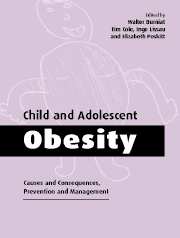Book contents
- Frontmatter
- Contents
- List of contributors
- Foreword
- Preface
- Part I Causes
- Part II Consequences
- Part III Prevention and management
- 12 Prevention
- 13 Home-based management
- 14 Dietary management
- 15 Management through activity
- 16 Psychotherapy
- 17 Drug therapy
- 18 Surgical treatment
- 19 Interdisciplinary outpatient management
- 20 Interdisciplinary residential management
- 21 The future
- Index
15 - Management through activity
Published online by Cambridge University Press: 02 November 2009
- Frontmatter
- Contents
- List of contributors
- Foreword
- Preface
- Part I Causes
- Part II Consequences
- Part III Prevention and management
- 12 Prevention
- 13 Home-based management
- 14 Dietary management
- 15 Management through activity
- 16 Psychotherapy
- 17 Drug therapy
- 18 Surgical treatment
- 19 Interdisciplinary outpatient management
- 20 Interdisciplinary residential management
- 21 The future
- Index
Summary
Introduction
Physical activity is usually included in treatment programmes for obesity and can be considered a cornerstone in management. Yet, what do we mean by physical activity? Too often physical activity is equated with formal exercise, since these two terms, physical activity and exercise, tend to be interchangeable although they refer to different constructs. For the purposes of this chapter and in conformity with the definitions used by others in this book, we have adopted the following definitions of physical activity, exercise and physical fitness (Caspersen et al., 1985):
Physical activity: any bodily movement produced by skeletal muscles which results in increased energy expenditure.
Exercise: a subcategory of physical activity which is repetitive, structured and purposive in the sense that improved maintenance of physical fitness is an objective.
Physical fitness: the ability to carry out daily tasks with vigour and alertness without undue fatigue and with ample energy to enjoy leisure-time pursuits and to meet unforeseen circumstances.
Physical activity programmes should be part of all multifaceted programmes for the treatment of childhood obesity. Skeletal muscle is the site of most fat oxidation in the body. Physical activity affects total fat oxidation and fat balance through promotion of more favourable body composition (loss of fat, especially of visceral fat; preservation of lean body mass). Moreover, increased fat oxidation rates help maintain glycogen stores, thus influencing the regulation of food intake and energy balance (Flatt, 1987a).
- Type
- Chapter
- Information
- Child and Adolescent ObesityCauses and Consequences, Prevention and Management, pp. 307 - 326Publisher: Cambridge University PressPrint publication year: 2002
- 8
- Cited by



